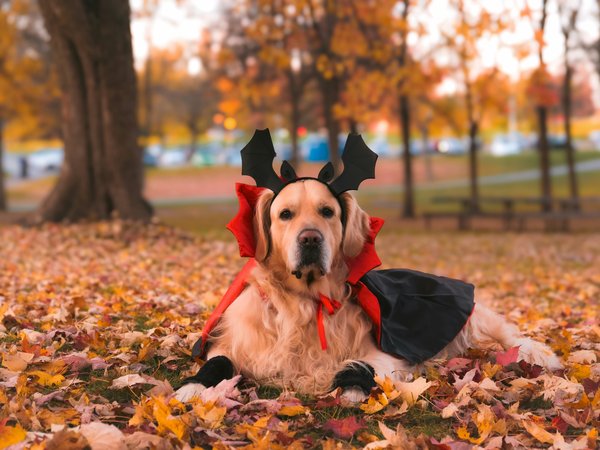Halloween festivities may entail spooky fun for humans, but they can be just plain scary for their dogs and cats.
From uncomfortable pet costumes to noisy trick-or-treaters to potentially toxic candy left lying around, four-legged pals have plenty of danger to face on Oct. 31.
So whether you're hosting a Halloween party or expecting to hand out lots of candy on Thursday, here are some tips from experts to help keep your furry friends safe:
How to choose a pet costume
While it may make for an adorable photo op to dress your pets in cute costumes, it's important to make sure they'll be safe and comfortable. When planning a pet's costume, make sure it fits properly and does not block the animal's sight, hearing, moving or breathing, the American Veterinary Medical Association said. Also, make sure your pet tries on the costume beforehand to get accustomed to it.
Brandywine Valley SPCA recommends removing any chewable parts or objects that can fall off the costume and present a choking hazard, the local shelter wrote in an Instagram post. If the costume has a mask or hat that fits around the face, it may be best to just keep that portion of the costume on for a quick pic to avoid discomfort or danger, the Humane Society of the United States said. If the pet shows signs of discomfort — like folded-down ears, eyes rolling back or sideways, a tucked tail, or hunching over — take off the costume.
An important part of your pet's "costume" is their identification, such as a microchip, collar and ID tag, just in case they escape through an open door while trick-or-treaters are in and out.
Keep pets away from candy
Do not share your candy with your animal pals. Leading up to Halloween and during trick-or-treating, make sure your excess candy is stashed in a high cabinet with a lock or child-safety latch so pets can't reach it. Foods like chocolate, raisins, gum and the sweetener xylitol can be hazardous for pets. Candy wrappers and plastic packaging should also be kept away from animals. Make sure young children know not to share their trick-or-treating loot with furry friends.
Along with steering clear of candy, pets should also be kept away from dangerous Halloween decor and items. Pieces of human Halloween costumes, rubber eyeballs, fake cobwebs, strung lights, lit candles, batteries, glow sticks and fake blood are some examples of what should be out of reach. The Humane Society suggests creating pet-friendly decor, like a cardboard box "haunted house" for cats, or placing treats and toys in a paper bag for a doggy version of trick-or-treating. Pumpkins are OK for dogs and cats to eat, but too much can cause digestive issues and rotting pumpkins can contain dangerous bacteria.
If your pet does ingest something dangerous, you can contact the 24-hour ASPCA Animal Poison Control Center hotline at 888-426-4435. You can also call your veterinarian ASAP.
How to limit pets' stress
The excitement of Halloween night can be anxiety-inducing for pets. To avoid stressing out dogs and cats, you can put your pets in a quiet room or crate them with treats, toys and soft music playing in the background. For cats, a spritz of a feline pheromone spray can help chill them out. You can also minimize the noise your indoor pets can hear by sitting outside to hand out candy, to remove the need for knocks on the door or doorbell ringing by trick-or-treaters.
When going out to trick-or-treat, leave your pets at home. They can be easily excited by all the Halloween activity, and also may be confused or frightened by people wearing masks and costumes.
Follow Franki & PhillyVoice on Twitter: @wordsbyfranki
| @thePhillyVoice
Like us on Facebook: PhillyVoice
Have a news tip? Let us know.

